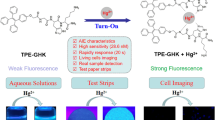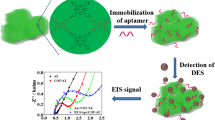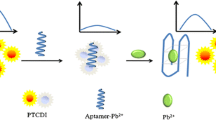Abstract
Lead contamination is a major concern in food safety and, as such, many lead detection methods have been developed, especially aptamer-based biosensors. However, the sensitivity and environmental tolerance of these sensors require improvement. A combination of different types of recognition elements is an effective way to improve the detection sensitivity and environmental tolerance of biosensors. Here, we provide a novel recognition element, an aptamer-peptide conjugate (APC), to achieve enhanced affinity of Pb2+. The APC was synthesized from Pb2+ aptamers and peptides through clicking chemistry. The binding performance and environmental tolerance of APC with Pb2+ was studied through isothermal titration calorimetry (ITC); the binding constant (Ka) was 1.76*106 M−1, indicating that the APC’s affinity was increased by 62.96% and 802.56% compared with the aptamers and peptides, respectively. Besides, APC demonstrated better anti-interference (K+) than aptamer and peptide. Through the molecular dynamics (MD) simulation, we found that more binding sites and stronger binding energy between APC with Pb2+are the reasons for higher affinity between APC with Pb2+. Finally, a carboxyfluorescein (FAM)-labeled APC fluorescent probe was synthesized and a fluorescent detection method for Pb2+ was established. The limit of detection of the FAM-APC probe was calculated to be 12.45 nM. This detection method was also applied to the swimming crab and showed great potential in real food matrix detection.
Graphical abstract








Similar content being viewed by others
References
Sridhar A, Kannan D, Kapoor A, Prabhakar S. Extraction and detection methods of microplastics in food and marine systems: a critical review. Chemosphere 2022;286(Pt 1):131653. https://doi.org/10.1016/j.chemosphere.2021.131653.
Zhang Y, Wu C, Liu H, Khan MR, Zhao Z, He G, Luo A, Zhang J, Deng R, He Q. Label-free DNAzyme assays for dually amplified and one-pot detection of lead pollution. J Hazard Mater. 2021;406:124790. https://doi.org/10.1016/j.jhazmat.2020.124790.
Wu Y, Shi Y, Deng S, Wu C, Deng R, He G, Zhou M, Zhong K, Gao H. Metal-induced G-quadruplex polymorphism for ratiometric and label-free detection of lead pollution in tea. Food Chem. 2021;343:128425. https://doi.org/10.1016/j.foodchem.2020.128425.
Malavolti M, Fairweather-Tait SJ, Malagoli C, Vescovi L, Vinceti M, Filippini T. Lead exposure in an Italian population: food content, dietary intake and risk assessment. Food Res Int. 2020;137:109370. https://doi.org/10.1016/j.foodres.2020.109370.
Handley MA, Nelson K, Sanford E, Clarity C, Emmons-Bell S, Gorukanti A, Kennelly P. Examining lead exposures in California through state-issued health alerts for food contamination and an exposure-based candy testing program. Environ Health Perspect. 2017;125(10):104503. https://doi.org/10.1289/EHP2582.
Chen X, Wang X, Lu Z, Luo H, Dong L, Ji Z, Xu F, Huo D, Hou C. Ultra-sensitive detection of Pb2+ based on DNAzymes coupling with multi-cycle strand displacement amplification (M-SDA) and nano-graphene oxide. Sensor Actuator B Chem. 2020;311:127898. https://doi.org/10.1016/j.snb.2020.127898.
Xu M, Wang X, Liu X. Detection of heavy metal ions by ratiometric photoelectric sensor. J Agric Food Chem. 2022;70(37):11468–80. https://doi.org/10.1021/acs.jafc.2c03916.
Xu Y, Kutsanedzie FYH, Ali S, Wang P, Li C, Ouyang Q, Li H, Chen Q. Cysteamine-mediated upconversion sensor for lead ion detection in food. J Food Meas Charact. 2021;15(6):4849–57. https://doi.org/10.1007/s11694-021-01054-x.
Martinello M, Dainese N, Manzinello C, Borin A, Gallina A, Mutinelli F. Retrospective evaluation of lead contamination in honey from 2005 to present in northeastern Italy and future perspectives in the light of updated legislation. Food Addit Contam B. 2016;9(3):198–202. https://doi.org/10.1080/19393210.2016.1170070.
Zhang X, Wang Z, Liu L, Zhan N, Qin J, Lu X, Cheng M. Assessment of the risks from dietary lead exposure in China. J Hazard Mater. 2021;418:126134. https://doi.org/10.1016/j.jhazmat.2021.126134.
Ferreira S, Bezerra M, Santos A, Santos L, Novaes C, Oliveir O, Oliveira M, Garcia L. Atomic absorption spectrometry e A multi element technique. TrAC Trends Anal Chem. 2018;(100):6. https://doi.org/10.1016/j.trac.2017.12.012.
Bogaerts A, Aghaei M. Inductively coupled plasma-mass spectrometry: insights through computer modeling. J Anal At Spectrom. 2017;32(2):233–61. https://doi.org/10.1039/C6JA00408C.
Chalyavi N, Doidge PS, Morrison RJS, Partridge GB. Fundamental studies of an atmospheric-pressure microwave plasma sustained in nitrogen for atomic emission spectrometry. J Anal At Spectrom. 2017;32(10):1988–2002. https://doi.org/10.1039/c7ja00159b.
Sivakumar R, Lee NY. Recent progress in smartphone-based techniques for food safety and the detection of heavy metal ions in environmental water. Chemosphere 2021;275:130096. https://doi.org/10.1016/j.chemosphere.2021.130096.
Khoshbin Z, Housaindokht MR, Izadyar M, Verdian A, Bozorgmehr MR. A simple paper-based aptasensor for ultrasensitive detection of lead (II) ion. Anal Chim Acta. 2019;1071:70–7. https://doi.org/10.1016/j.aca.2019.04.049.
Wang D, Ge C, Lv K, Zou Q, Liu Q, Liu L, Yang Q, Bao S. A simple lateral flow biosensor for rapid detection of lead(ii) ions based on G-quadruplex structure-switching. Chem Commun (Camb). 2018;54(97):13718–21. https://doi.org/10.1039/c8cc06810k.
Ravindran N, Kumar S, Yashini M, Rajeshwari S, Mamathi A, Thirunavookarasu N, Sunil K. Recent advances in surface plasmon resonance (SPR) biosensors for food analysis: a review. Crit Rev Food Sci Nutr. 2021;63(8):1055–77. https://doi.org/10.1080/10408398.2021.1958745.
Ling S, Zhao Q, Iqbal MN, Dong M, Li X, Lin M, Wang R, Lei F, He C, Wang S. Development of immunoassay methods based on monoclonal antibody and its application in the determination of cadmium ion. J Hazard Mater. 2021; 411:124992. https://doi.org/10.1016/j.jhazmat.2020.124992.
Zhang Y, Hu Y, Deng S, Yuan Z, Li C, Lu Y, He Q, Zhou M, Deng R. Engineering multivalence aptamer probes for amplified and label-free detection of antibiotics in aquatic products. J Agric Food Chem. 2020;68(8):2554–61. https://doi.org/10.1021/acs.jafc.0c00141.
Hu J, Zhou S, Zeng L, Chen Q, Duan H, Chen X, Li X, **ong Y. Hydrazide mediated oriented coupling of antibodies on quantum dot beads for enhancing detection performance of immunochromatographic assay. Talanta 2021; 223 (Pt 1):121723. https://doi.org/10.1016/j.talanta.2020.121723.
Lotfi Zadeh Zhad HR, Lai RY. Application of calcium-binding motif of E-cadherin for electrochemical detection of Pb(II). Anal Chem. 2018;90(11):6519–25. https://doi.org/10.1021/acs.analchem.7b05458.
Yin N, Zhao R, Zhang J, Yang D, Guo Z, Liu R, Yao X. A lable-free SPR biosensor based on one peptide sequence with three recognition sites for O-GlcNAc transferase detection. Talanta 2021;222:121664. https://doi.org/10.1016/j.talanta.2020.121664.
Elcin E, Öktem HA. Inorganic cadmium detection using a fluorescent whole-cell bacterial bioreporter. Anal Lett. 2020;53(17):2715–33. https://doi.org/10.1080/00032719.2020.1755867.
Wang XY, Yang T, Wang SY, Du KD, Chen ML, Wang JH. M13 phage as network frame for the quantification of Pb(2+) based on the Pb(2+)-induced in-situ growth of gold nanoparticles. Anal Chim Acta. 2019;1073:72–8. https://doi.org/10.1016/j.aca.2019.04.065.
Li S, Ma X, Pang C, Tian H, Xu Z, Yang Y, Lv D, Ge H. Fluorometric aptasensor for cadmium(II) by using an aptamer-imprinted polymer as the recognition element. Microchim Acta. 2019;186(12):823. https://doi.org/10.1007/s00604-019-3886-7.
Sahin S, Caglayan MO, Ustundag Z. A review on nanostructure-based mercury (II) detection and monitoring focusing on aptamer and oligonucleotide biosensors. Talanta 2020;220:121437. https://doi.org/10.1016/j.talanta.2020.121437.
Wu Y, Yue Y, Deng S, He G, Gao H, Zhou M, Zhong K, Deng R. Ratiometric-enhanced G-quadruplex probes for amplified and mix-to-read detection of mercury pollution in aquatic products. J Agric Food Chem. 2020;68(43):12124–31. https://doi.org/10.1021/acs.jafc.0c05658.
Matsunaga K, Okuyama Y, Hirano R, Okabe S, Takahashi M, Satoh H. Development of a simple analytical method to determine arsenite using a DNA aptamer and gold nanoparticles. Chemosphere. 2019;224:538–43. https://doi.org/10.1016/j.chemosphere.2019.02.182.
Dolati S, Ramezani M, Abnous K, Taghdisi SM. Recent nucleic acid based biosensors for Pb2+ detection. Sensor Actuator B Chem. 2017;246:864–78. https://doi.org/10.1016/j.snb.2017.02.118.
Chen Z, Liu C, Su X, Zhang W, Zou X. Signal on-off ratiometric electrochemical sensor based on semi-complementary aptamer couple for sensitive cadmium detection in mussel. Sensor Actuator B Chem. 2021; 346:130506. https://doi.org/10.1016/j.snb.2021.130506.
Yu H, Zhao Q. Sensitive microscale thermophoresis assay using aptamer thermal switch. Anal Chem. 2022;94(48):16685–91. https://doi.org/10.1021/acs.analchem.2c0306832.
Zhao Y, Yavari K, Liu J. Critical evaluation of aptamer binding for biosensor designs. TrAC, Trends Anal Chem. 2022; 146:116480. https://doi.org/10.1016/j.trac.2021.116480.
Bashir A, Yang Q, Wang J, Hoyer S, Chou W, McLean C, Davis G, Gong Q, Armstrong Z, Jang J, Kang H, Pawlosky A, Scott A, Dahl GE, Berndl M, Dimon M, Ferguson BS. Machine learning guided aptamer refinement and discovery. Nat Commun. 2021;12(1):2366. https://doi.org/10.1038/s41467-021-22555-9.
Amero P, Lokesh GLR, Chaudhari RR, Cardenas-Zuniga R, Schubert T, Attia YM, Montalvo-Gonzalez E, Elsayed AM, Ivan C, Wang Z, Cristini V, Franciscis V, Zhang S, Volk DE, Mitra R, Rodriguez-Aguayo C, Sood AK, Lopez-Berestein G. Conversion of RNA aptamer into modified DNA aptamers provides for prolonged stability and enhanced antitumor activity. J Am Chem Soc. 2021;143(20):7655–70. https://doi.org/10.1021/jacs.9b10460.
Wu Y, Zhan S, Wang L, Zhou P. Selection of a DNA aptamer for cadmium detection based on cationic polymer mediated aggregation of gold nanoparticles. Analyst. 2014;139(6):1550–61. https://doi.org/10.1039/c3an02117c.
Wang H, Cheng H, Wang J, Xu L, Chen H, Pei R. Selection and characterization of DNA aptamers for the development of light-up biosensor to detect Cd(II). Talanta. 2016;154:498–503. https://doi.org/10.1016/j.talanta.2016.04.005.
Yu R, Fang Z, Meng W, Yan Z, Du L, Wang H, Liu Z. High specificity detection of Pb2+ ions by p-SCN-Bz-DTPA immunogen and p-NH2-Bn-DTPA coating antigen. Front Env Sci Eng. 2013;8(5):729–36. https://doi.org/10.1007/s11783-013-0611-3.
Lee J-W, Choi H, Hwang U-K, Kang J-C, Kang YJ, Kim KI, Kim J-H. Toxic effects of lead exposure on bioaccumulation, oxidative stress, neurotoxicity, and immune responses in fish: a review. Environ Toxicol Pharmacol. 2019;68:101–8. https://doi.org/10.1016/j.etap.2019.03.010.
Okuda N, Okayama A, Miura K, Yoshita K, Miyagawa N, Saitoh S, Nakagawa H, Sakata K, Chan Q, Elliott P, Ueshima H, Stamler J. Food sources of dietary potassium in the adult Japanese population: the International Study of Macro-/Micronutrients and Blood Pressure (INTERMAP). Nutrients. 2020;12(3):787. https://doi.org/10.3390/nu12030787.
Wang W, ** Y, Zhao Y, Yue X, Zhang C. Single-labeled hairpin probe for highly specific and sensitive detection of lead(II) based on the fluorescence quenching of deoxyguanosine and G-quartet. Biosens Bioelectron. 2013;41:137–42. https://doi.org/10.1016/j.bios.2012.08.006.
Wang H, Wang DM, Huang CZ. Highly sensitive chemiluminescent detection of lead ion based on its displacement of potassium in G-quadruplex DNAzyme. Analyst. 2015;140(16):5742–7. https://doi.org/10.1039/c5an00884k.
Kimoto M, Nakamura M, Hirao I. Post-ExSELEX stabilization of an unnatural-base DNA aptamer targeting VEGF165 toward pharmaceutical applications. Nucleic Acids Res. 2016;44(15):7487–94. https://doi.org/10.1093/nar/gkw619.
Zhu C, Zhao Y, Yan M, Huang Y, Yan J, Bai W, Chen A. A sandwich dipstick assay for ATP detection based on split aptamer fragments. Anal Bioanal Chem. 2016;408(15):4151–8. https://doi.org/10.1007/s00216-016-9506-z.
Gao S, Zheng X, Jiao B, Wang L. Post-SELEX optimization of aptamers. Anal Bioanal Chem. 2016;408(17):4567–73. https://doi.org/10.1007/s00216-016-9556-2.
Chinnappan R, AlZabn R, Fataftah AK, Alhoshani A, Zourob M. Probing high-affinity aptamer binding region and development of aptasensor platform for the detection of cylindrospermopsin. Anal Bioanal Chem. 2020;412(19):4691–701. https://doi.org/10.1007/s00216-020-02723-4.
Wang Z, Yang X, Lee NZ, Cao X. Multivalent aptamer approach: designs, strategies, and applications. Micromachines. 2022;13(3):436. https://doi.org/10.3390/mi13030436.
Khoshbin Z, Housaindokht MR, Izadyar M, Bozorgmehr MR, Verdian A. Theoretical design and experimental study of new aptamers with the improved target-affinity: new insights into the Pb2+-specific aptamers as a case study. J Mol Liq. 2019; 289:111159. https://doi.org/10.1016/j.molliq.2019.111159.
Sun H, Li X, Li Y, Fan L, Kraatz HB. A novel colorimetric potassium sensor based on the substitution of lead from G-quadruplex. Analyst. 2013;138(3):856–62. https://doi.org/10.1039/c2an36564b.
Ratajczak K, Lukasiak A, Grel H. Monitoring of dynamic ATP level changes by oligomycin-modulated ATP synthase inhibition in SW480 cancer cells using fluorescent “On-Off” switching DNA aptamer. Anal Bioanal Chem. 2019;411(26):6899–911. https://doi.org/10.1007/s00216-019-02061-0.
Malavolti M, Naska A, Fairweather-Tait SJ, Malagoli C, Vescovi L, Marchesi C, Vinceti M, Filippini T. Sodium and potassium content of foods consumed in an Italian population and the impact of adherence to a Mediterranean diet on their intake. Nutrients. 2021;13(8):2681. https://doi.org/10.3390/nu13082681.
Yang C, Yang S, Li J, Du Y, Song L, Huang D, Chen J, Zhou Q, Yang Q, Tang Y. Intelligent sensors of lead based on a reconfigurable DNA-supramolecule logic platform. Anal Chem. 2018;90:10585–90. https://doi.org/10.1021/acs.analchem.8b02782.
Funding
National Natural Science Foundation of China (32272421) and National Natural Science Foundation of China (32072312). This work was partly supported by the Science and Technology Innovation Action Plan of Shanghai (20392001600).
Author information
Authors and Affiliations
Ethics declarations
Conflict of interest
The authors declare no competing interests.
Additional information
Publisher's note
Springer Nature remains neutral with regard to jurisdictional claims in published maps and institutional affiliations.
Supplementary Information
Below is the link to the electronic supplementary material.
Rights and permissions
Springer Nature or its licensor (e.g. a society or other partner) holds exclusive rights to this article under a publishing agreement with the author(s) or other rightsholder(s); author self-archiving of the accepted manuscript version of this article is solely governed by the terms of such publishing agreement and applicable law.
About this article
Cite this article
Peng, K., Liu, X., Yuan, H. et al. A novel fluorescent biosensor based on affinity-enhanced aptamer-peptide conjugate for sensitive detection of lead(II) in aquatic products. Anal Bioanal Chem 415, 3463–3474 (2023). https://doi.org/10.1007/s00216-023-04735-2
Received:
Revised:
Accepted:
Published:
Issue Date:
DOI: https://doi.org/10.1007/s00216-023-04735-2




